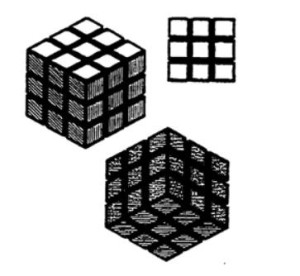A recent case before the European Court of Justice has dealt with the interesting question of how Article 7(1)(e)(ii) of Regulation No 40/94 (now replaced by Regulation 207/2009), which provides that signs which consist exclusively of the shape of goods necessary to obtain a technical result shall not be registered, should be assessed.
Thereby, German toy company Simba Toys GmbH & Co. KG (Simba) appealed a judgement of the General Court relating to EU trademark no. 162784, showing the three-dimensional representation of a Rubik’s cube:
Simba had previously filed an application for a declaration of invalidity of this mark which had been rejected by the EUIPO at every instance. A subsequent action seeking annulment had also been dismissed as unfounded by the General Court.
Thus, the General Court had considered that the essential characteristics of the cube shape did not perform a technical function of the goods at issue, namely three-dimensional puzzles. In this context, the General Court had argued that the rotating capability of the individual elements of the cube could not result from the characteristics of the shape, but rather from an invisible mechanism internal to the cube. Further, inferring such a mechanism from the graphic representation of the mark would not be consistent with the requirement that any inference must be drawn as objectively as possible from the shape in question, as represented graphically, and with sufficient certainty. Any additional circumstances which the objective observer could not “fathom precisely” on the basis of the graphic representation were not to be considered. Therefore, the General Court found the grid structure did not perform a technical function as the structure had the effect of dividing each surface of the cube visually into nine equal square elements. This did not constitute a technical function for the purpose of the relevant case law.
Simba inter alia based its appeal to the Court of Justice on the argument that in coming to this conclusion, the General Court had failed to apply the provisions of Article 7(1)(e)(ii) correctly.
Annulling the previous decision and following this reasoning, the Court indicated that the General Court had indeed interpreted the criteria for assessing Article 7(1)(e)(ii) too narrowly. This provision above all sought to prevent trademark law from granting an undertaking a monopoly on technical solutions or functional characteristics of a product. Thereby, in a first step, the essential characteristics of the three-dimensional sign at issue had to be identified. In the present case, the characteristics comprised of a cube and a grid structure in each surface of the cube. Further, it was necessary to assess whether such characteristics performed a technical function of the relevant product. Whilst the shape at issue, as represented graphically, had to be considered in this context, the technical function of the actual goods at issue, i.e. three-dimensional puzzles with a rotating capability, should also have been examined by the General Court, even if the mark was registered only for three dimensional puzzles in general, without being restricted to those having a rotating capability.
In light of this, the General Court had failed to apply Article 7(1)(e)(ii) correctly. In particular, the Court held that even though the contested mark was registered for three dimensional puzzles, it was not possible to ignore the technical function of the actual goods represented by the sign. Doing so would result in the proprietor being able to broaden the scope of protection afforded by his mark to cover any type of puzzle with an identical or similar shape, i.e. any three-dimensional puzzle with cube-shaped elements, regardless of the principles by which it functioned. This would, however, run contrary to the key objective pursued of this provision and therefore the decision of the General Court could not be followed.
Whilst this decision certainly is in line with previous rulings concerning similar cases, I would regard it as somewhat puzzling. Thus, in particular the question arises why this shape which is so well-known, some might even say iconic, and therefore is perceived as a trademark by the public, is not granted the protection it should be due.
_____________________________
To make sure you do not miss out on regular updates from the Kluwer Trademark Blog, please subscribe here.



